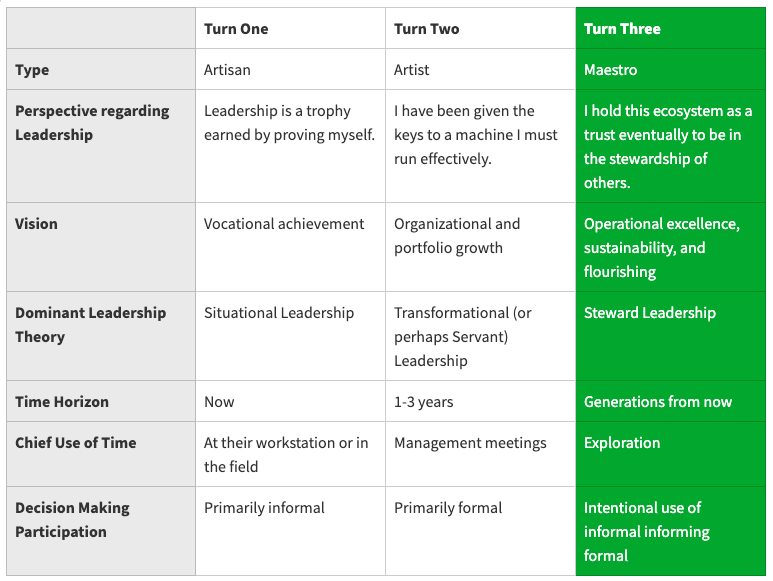
Before we suggest a helpful exercise with this chart, we would like to emphasize a couple of things:
-
Most people will spend their entire career building their artisanship. What they do as Turn Two or Three is lived in family, community, and outside interests.
-
Some people will have a solid career in Turn Two, leading others and leading an organization. An example might be a person who specializes in leading turnaround events to get a company profitable again. Three years here. Two years there. Five years at another place. Their Turn Three experiences will likely be post-retirement.
-
A few people will have an opportunity in Turn Three while leading an organization they established, built, and/or guided for an extended period.
-
The role a person plays in an organization may or may not match their level of development. Problems develop when their position requires something more than their current developmental state and when no developmental plan is in place. Hence the phrase "a Turn One person in a Turn Two role."
-
Even though Maestro-level leaders is a resource to gather and aid Third-turn leaders, the Third Turn is not superior in comparison to the other turns. Instead, it is what comes next for accomplished leaders as they give themselves to building future value that others will eventually steward.
-
Finally, we note that no one abandons a Turn as they have the opportunity to move to the next. Third-turn leaders need to keep governing themselves and to lead people and the organization effectively. However, they developed good habits, including pruning the good they could be doing away from the best things that drive value. They also developed the leadership capacity of others. They now can devote themselves more fully to the future value of the organization.
What do we mean by future value? It's pretty simple.
-
The future is a time that is not now. Third turn leaders use the now to build toward a preferred future.
-
The organization defines value. If it is a well-aligned organization, then value essentially means accomplishing the mission it sets for itself.
Future value, then, is essentially more of the mission.
Where future value gets far less simple is designing how to do more of the mission in light of a misty and volatile future. More of the mission requires deep thought, experimentation, adaptability, and the luxury of time. That luxury comes because of the excellent self-governance and development of others laid down in those first two turns of executive leadership. It sets the Third-turn leader to do what no one else can do.
___________________________________
We invite you to digest this chart and then completing the following exercise:
-
Work through each row and ask yourself in which box you would place yourself. Then ask what might be needed to help you move further right.
-
Work through each row and ask yourself which box you would place each executive team member. What might be done to help them move further right?
-
Invite your team to individually self-assess -- perhaps as part of a quarterly or annual review. How do they see themselves? What do they consider necessary to help them move further right?
Learn more about Maestro-level leaders cohorts here.
Access the Third Turn Podcast here.
Tags:
Mark L. Vincent, Design Group International, Executive Development, Maestro-level Leaders, The Third Turn, The Third Turn Podcast, executive leadership development
Post by
Mark L. Vincent
May 13, 2021
May 13, 2021
I walk alongside leaders, listening to understand their challenges, and helping them lead healthy organizations that flourish.
Comments